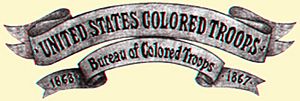Bureau of Colored Troops facts for kids
The Bureau of Colored Troops was an important office created during the American Civil War. The U.S. War Department started it on May 22, 1863. Its main job was to manage everything about organizing and supporting African American soldiers. These soldiers were often called "colored troops" at the time.
Major Charles W. Foster led the Bureau. It helped change the names of these units from state titles to United States Colored Troops. This made them a more official part of the Union Army.
Contents
How African Americans Joined the Army
At first, African Americans were not allowed to fight in the Union Army. A law passed in July 1862, called the Second Confiscation and Militia Act, changed this. It allowed President Abraham Lincoln to use African Americans for military service. However, they were mostly used for labor, not combat.
Everything changed on January 1, 1863, with the Emancipation Proclamation. This famous order declared many enslaved people free. It also said that suitable African Americans could join the army. They could serve in forts, stations, and on ships. This was a big step for the Union Army.
As more African Americans wanted to join, the War Department needed help. Managing all these new soldiers was a huge task. So, in mid-1863, they created the Bureau of Colored Troops. This new office helped organize black units and find officers for them. It also kept track of all the information about these units. Over time, black commands became known as United States Colored Troops. They were organized into infantry, artillery, or cavalry units.
Challenges and Unequal Treatment
The Bureau of Colored Troops helped make the USCT regiments more organized. However, these soldiers often faced unfair treatment. Black leaders wanted black officers, but the Bureau usually assigned only white men as officers. A few black soldiers did become officers later, like Martin Delany. Many also served as non-commissioned officers. Still, white officers mostly led the USCT.
Many army officials thought black soldiers would not be used in combat. Because of this, black soldiers often had to do more hard labor. They also faced unfair pay. White soldiers were paid $13 per month. But black soldiers initially received only $10 per month, with $3 of that in clothing. This was the pay rate for military laborers. Black soldiers were also often denied special payments given to white soldiers for joining. They rarely received aid for their families, which white soldiers often got.
Key Supporters of Black Soldiers
After the Emancipation Proclamation, recruiting black soldiers became a major goal. The first black regiments came from states like South Carolina, Tennessee, and Massachusetts. But recruitment was slow at first.
Important African American leaders helped encourage more men to join. Frederick Douglass, a famous writer and speaker, urged black men to become soldiers. He believed that serving in the army would help them gain full citizenship rights. Martin Delany was another key supporter. He became one of the first African American field officers in the United States Army. Delany actively helped recruit black men for the United States Colored Troops. Their efforts helped more volunteers respond. This led to the government establishing the Bureau of Colored Troops in May 1863.
Images for kids


